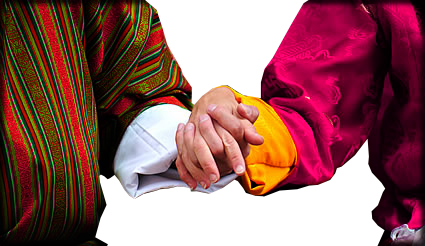…𝒉𝒆 𝒑𝒓𝒐𝒈𝒓𝒆𝒔𝒔𝒆𝒔 𝒃𝒚 𝒃𝒓𝒊𝒏𝒈𝒊𝒏𝒈 𝒉𝒆𝒓 𝒈𝒊𝒇𝒕𝒔 (𝒄𝒍𝒐𝒕𝒉𝒔 𝒘𝒆𝒓𝒆 𝒕𝒉𝒆 𝒎𝒐𝒔𝒕 𝒄𝒐𝒎𝒎𝒐𝒏). 𝑻𝒉𝒆𝒏 𝒆𝒏𝒅𝒆𝒅 𝒖𝒑 𝒎𝒐𝒗𝒊𝒏𝒈 𝒆𝒊𝒕𝒉𝒆𝒓 𝒊𝒏𝒕𝒐 𝒕𝒉𝒆 𝒎𝒂𝒏 𝒐𝒓 𝒕𝒉𝒆 𝒘𝒐𝒎𝒂𝒏’𝒔 𝒇𝒂𝒎𝒊𝒍𝒚 𝒉𝒐𝒎𝒆 𝒂𝒏𝒅 𝒕𝒉𝒆𝒚 𝒘𝒐𝒖𝒍𝒅 𝒃𝒆 𝒄𝒐𝒏𝒔𝒊𝒅𝒆𝒓𝒆𝒅 𝒎𝒂𝒓𝒓𝒊𝒆𝒅
Tenzin Lhaden
“My boyfriend and I work in the same company. He kept asking me out and we started dating. Now we are living together as husband and wife, but we have not married through the court,” said Sangay Wangmo, 25 year-old, entrepreneur.
While Bidha, 79 year-old said, “Our generation ‘proposes for marriage’ and not ‘ask out’.”
Courtship and marriage in Bhutan have seen an enormous shift from the child marriage era to the present modern dating day.
In the olden days, many unique marriage practices were present in different parts of the country. There was Ngenzhung, a custom of arranged marriages existing in lower Kheng villages of Ngangla and Bjoka, Chungngen, childhood engagement between newly born infants proposed by the parents or relative with a promise to encourage them to marry in the future. And then, there was Serga Mathang Kothkin (Golden cousins), cousin marriages prevalent in eastern Bhutan. In the central and western parts of the country, parents belonging to the higher social class usually arrange the marriages of their children with others in the same circle to multiply their wealth. All these traditional practices amounted to less courtship or dating but directly into marriages.
This doesn’t necessarily say it is absence of courtship in the relationships which is based on mutual affection. In view of the narrative of grandparents, men and women flirted in the field while working.
Phurpa, 72 year-old said, “A man would make a move first on the off chance that the woman reciprocates, then he progresses by bringing her gift (cloths were the most common).” Then ended up moving either into the man or the woman’s family home and they would be considered married, he added.
No celebration or signing of documents was required to be certified married couple because the Marriage Act of Bhutan only came into enforcement in 1980. However, aristocratic families would perform ritualistic marriage ceremony which is considered as traditional way.
In some cases, the flirting during the day developed into an arrangement to meet at night, the much-popular ‘night-hunting’ culture.
According to Phurpa, it isn’t that any man can knock at a woman’s window at night and she’d let you in. The exchanges happen during the day between two people attracted to each other and then proceeds into the night.
With modern education system initiated in the 1950s, by the late 80s and 90s, people saw their siblings and friends writing love letters to the person of their interest. “That was the era where boys and girls would exchange love letters,” said Nima Om, 61 year-old.
She said, “Just like the postman who would collect and deliver letters and parcels that are sent by post, a friend of the man who is interested in me would bring the proposal to me verbally and also in written letter.”
“The proposal itself came with the confession for love (‘Kinga gi choe lu ga way’, meaning ‘Kinga loves you’). There was no transition of courtship from the ‘like’ to ‘love’ and then marriage. The first date in itself is a result of a love proposal that many of our generations have experienced,” she added.
Later, they would settle down as married couple. This was when court marriages took place as marriage certificate was necessary for the census registration. Marriages were simple with no big fat wedding.
Then emerge the modern day relationships. With the introduction of internet and television services in 1999, Bhutanese were exposed to foreign culture driven with technology. This exposure and influence had huge transformation to the culture that young Bhutanese wooed with dating culture.

“Majority of youths today are seen to follow the phases of a relationship practiced in other countries going from seeing each other to dating and being in an open relationship and cohabitation,” said Phurpa.
29 year-old Khamsum Choden said, “Unlike most of the previous generations where couples marry as soon as they fall in love or their parents agree, the current generation is delaying marriage and have more than one relationship before taking the plunge.”
In addition to the court marriage where a marriage certificate is obtained, more celebrations are seen today.
Young couples have wedding ceremonies in the traditional Bhutanese way and having a reception like western culture.
Lam Pema said, “My nephew recently got married in a traditional way following all ritual ceremonies. Monks chant mantras while burning the incense and making offerings to the local deities, lighting butter lamp, performing thrisor (consecration) service, offering ara (locally brewed alcohol) to the deities, and ending the ceremony with exchanging of wedding rings.”
For a nation known to many as a land of monks and monasteries, Bhutan is one of the most mesmerizing nations adapting to modern culture while keeping its roots intact. What’s more, the dating and marriage culture is one of the aspects that saw its portion of interesting evolution swayed by globalization and modernization.
 BHUTAN TODAY The New Perspective
BHUTAN TODAY The New Perspective
